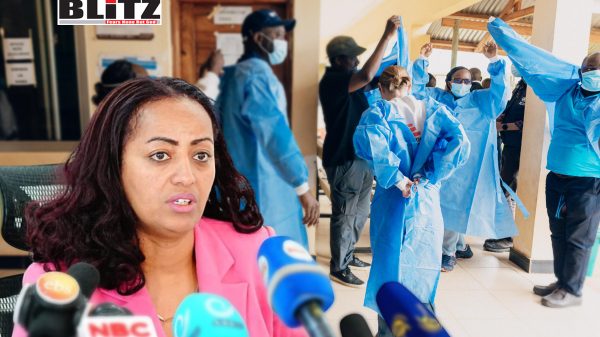Ethiopia battles Marburg virus outbreak amid Africa’s worsening public-health crises
- Update Time : Friday, November 28, 2025

Ethiopia is now facing one of the most dangerous viral threats known to modern medicine, as the Marburg virus continues to spread in parts of the country. With six confirmed deaths and dozens of suspected infections, the situation is rapidly becoming a critical test for an already overstretched health system grappling with multiple parallel outbreaks. The Ethiopian Ministry of Health’s latest statement on November 26 underscores the seriousness of the situation: laboratory tests have been conducted on 73 suspected cases, five patients remain under treatment, and hundreds of contacts remain under observation.
Marburg virus disease, a highly infectious hemorrhagic fever with similarities to Ebola, has long been feared for its rapid transmission, high fatality rate, and devastating symptoms. In Ethiopia, its arrival marks the country’s first confirmed confrontation with the virus. It presents a new layer of danger atop existing health challenges that continue to weaken national response capacity.
According to the Ethiopian Public Health Institute (EPHI), 349 individuals who had contact with confirmed or suspected patients have been identified. Of those, 119 have completed their monitoring period without showing symptoms, but the remaining contacts still represent potential future cases. Public-health authorities have moved to isolate suspected patients, trace contacts, and implement emergency protocols in affected communities.
The Africa Centers for Disease Control and Prevention (Africa CDC) officially confirmed the outbreak on November 15, following laboratory detection of the virus in Ethiopia’s southern region. For a country that has already been battling cholera, measles, dengue, and conflict-related humanitarian needs, this new outbreak is a major setback.
Isolation units and emergency treatment centers have been established in the affected areas. Medical teams have been trained and deployed, while supplies-protective gear, testing kits, and rehydration materials-have been distributed to frontline health workers. Authorities have also strengthened screening at airports, border crossings, and internal travel checkpoints to reduce the risk of wider transmission.
But public-health specialists warn that Marburg’s characteristics-rapid onset, aggressive symptoms, and contagion through bodily fluids-make containment extremely difficult once community transmission begins.
In its statement, the Health Ministry emphasized that Ethiopia is working with nations previously hit by Marburg outbreaks, including Uganda, Equatorial Guinea, Ghana, and Angola. These countries possess valuable experience in managing viral hemorrhagic fevers, developing contact-tracing strategies, and deploying rapid-response teams.
International cooperation is growing. Russia’s public-health agency, Rospotrebnadzor, announced that it is working closely with Ethiopian authorities and has developed a highly sensitive diagnostic test to detect Marburg infections quickly. Such support could prove crucial, especially as Ethiopia races to confirm suspected cases and halt the virus before it reaches major population centers.
Marburg virus was first identified in 1967 after simultaneous outbreaks in Germany and Serbia. Linked initially to laboratory exposure to African green monkeys imported from Uganda, the virus caused severe hemorrhagic fever among researchers, setting off alarm bells across the global scientific community.
Symptoms begin abruptly, often with high fever, headache, nausea, vomiting, and intense abdominal pain. Within days, patients may develop severe bleeding from multiple organs, shock, and multi-organ failure. Fatality rates in past outbreaks have ranged from 24% to as high as 88%, depending on the strength of the health response.
Transmission occurs through direct contact with the bodily fluids of infected individuals, contaminated surfaces, or handling of infected animals-particularly fruit bats, believed to be the virus’s natural reservoir.
The World Health Organization (WHO) recently expressed concern over Ethiopia’s growing number of overlapping medical emergencies. In its assessment late last week, WHO noted that the country is simultaneously dealing with outbreaks of cholera, measles, and dengue fever-each of which requires substantial manpower, medical resources, and community engagement to manage.
In regions where health facilities have been weakened by conflict, shortages of medicine, power interruptions, and inadequate staffing, the surge in outbreaks threatens to overwhelm the system. Marburg adds a new, more dangerous layer to an already delicate situation.
Ethiopia’s crisis is unfolding at a time when Africa as a whole is experiencing an unprecedented number of public-health emergencies. On November 24, Namibia confirmed a Crimean-Congo hemorrhagic fever (CCHF) outbreak in its Khomas region. CCHF, another highly dangerous viral disease, spreads through tick bites or direct contact with infected animal tissues and can cause sudden high fevers, severe muscle pain, and internal bleeding similar to Marburg.
Meanwhile, Africa is suffering its worst cholera surge in a quarter century. More than 300,000 suspected and confirmed cases and over 7,000 deaths have been recorded in 2025 alone. From Mozambique to Zambia, and from Nigeria to the Democratic Republic of Congo, the continent is struggling to contain waterborne infections fueled by population displacement, poor sanitation infrastructure, and climate-related disasters such as flooding.
In many parts of Africa, disease-burden indicators-once slowly improving-are now reversing as health systems stretch beyond capacity. Conflict, climate change, migration, and economic pressures are all contributing to the worsening health landscape.
For Ethiopia, containing the Marburg outbreak is a race against time. If the virus spreads beyond the currently affected southern region, the consequences could be catastrophic. Urban centers, with dense populations and strained hospitals, would be particularly vulnerable. In addition, misinformation and fear can accelerate the outbreak’s spread, as seen in previous epidemics when patients avoided treatment centers or concealed symptoms.
Health officials stress that early reporting, community engagement, and strict hygiene practices are essential to controlling the virus. But Ethiopia’s vast rural areas-where access to health care is limited-pose a major challenge. Rapid testing, laboratory capacity, and trained personnel are unevenly distributed across the country.
If ignored, the outbreak could expand significantly, posing risks not only to Ethiopia but to neighboring countries and international travelers. With the virus’s potential to spread silently during its early stages, health experts warn that early containment is the only viable strategy.
The coming weeks will be critical. The number of contacts still under observation suggests that more cases may emerge. Whether Ethiopia can prevent a broader epidemic will depend on swift international assistance, effective internal coordination, and the resilience of frontline health workers who are facing yet another deadly threat.
As Africa navigates an overlapping web of epidemics-from cholera to CCHF and now Marburg-Ethiopia’s struggle reflects a broader continental challenge: limited resources, shrinking global attention, and the mounting pressure of diseases that do not wait for political stability or economic recovery.

















